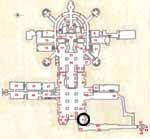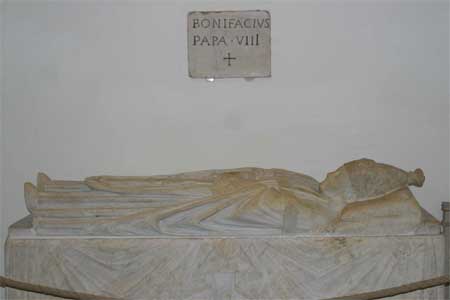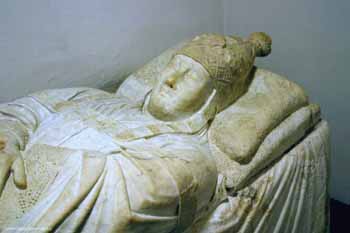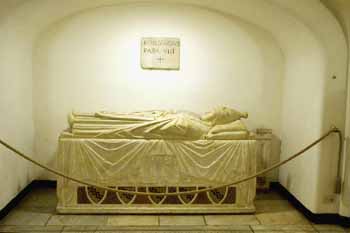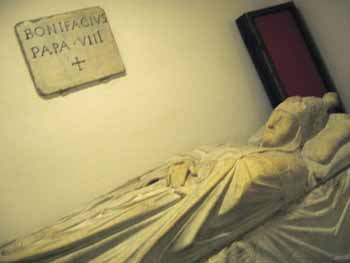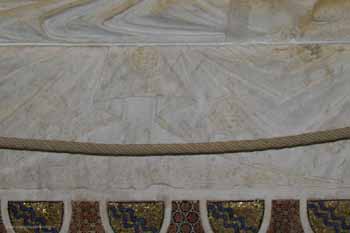| Grottoes
Vatican City Colonnade Saints Floorplan #2 |
| Altars
Monuments The History |
|
|
|
Related
Links
|
|
|
|
|
|
|
|
|
|
|
|
|
|
|
|
From the very start of his pontificate, the pope wished to build a shrine against the inner facade of the ancient basilica, between the central door and the Ravenna Door. The intention was to create a noble chapel dedicated to St Boniface IV that was to become the burial place for the pope himself as well as for his relatives. The commission was entrusted to the most prestigious artist of the time, Arnolfo di Cambio. The altar was consecrated on May 6, 1296, but the work was completed only in 1301. In the wall above the altar was an ample niche where the sarcophagus with the body of Boniface VIII was to be placed after the pope's death. Above the sarcophagus was a mosaic attributed to Jacopo Torriti, representing the Madonna and Child in a clipeum in the sky, while to the right was St Peter presenting the genuflected Boniface VIII to the Virgin. To the left was the figure of St Paul. The relics of St Boniface were sealed in under the table of the altar. The entire structure was dominated by an elegant ciborium where four classical fluted columns on high bases supported an octagonal dome decorated with light pointed needles. Next to the shrine was the bust of Boniface VIII imparting his blessing - another work by Arnolfo di Cambio, today in the Apostolic Palaces. When the facade of the old basilica was demolished, the ciborium and the altar of St Boniface had to be dismantled. On October 11, 1605, the sarcophagus was opened and after three hundred years the pope's robust body was found, still dressed in the papal vestments. It was sealed again and taken down to the grottoes, but the surveys of 1835 and 1950 revealed major deterioration of the remains. The relics of St Boniface, instead, were translated to the altar of St Thomas the Apostle in the new basilica, while the ancient inscription is still on display in the chapel of Partorienti. On front of the marble coffin is a fine embroidered drapery decorated with elements from the family crest of the Caetani. The same decorative pattern appears in the mosaic below. The lying figure of the pope is at the same time schematic in lines and volume and highly individual on the face. With his outstanding skill Arnolfo shows the physical appearance of the pope as well as his personality. The papal vestments are sculpted in great detail showing the style of the epoch with the tiara with two crowns, the custom introduced by this pope. On the wall above is a small plaque with the name of the pope: BONIFACTVS / PAPA VIII. To the right from the sarcophagus is a small pillar with the papal crest, originally from the ancient ciborium. On the floor in front of the sarcophagus is an inscription indicating the presence of the remains of one of the pope's nephews. |
||||
|
|
||||
| Source: Roma Sacra The Vatican Grottoes, © Fabbrica of St. Peter's, June 2003 |
This independent website is not endorsed by or associated with the Vatican, the Fabbrica of St. Peter's, or any business organization
Contact:
stpetersbasilica@gmail.com
